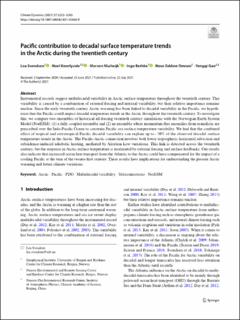| dc.contributor.author | Svendsen, Lea | |
| dc.contributor.author | Keenlyside, Noel | |
| dc.contributor.author | Muilwijk, Morven | |
| dc.contributor.author | Bethke, Ingo | |
| dc.contributor.author | Omrani, Nour-Eddine | |
| dc.contributor.author | Gao, Yongqi | |
| dc.date.accessioned | 2022-01-28T11:47:47Z | |
| dc.date.available | 2022-01-28T11:47:47Z | |
| dc.date.created | 2021-08-16T11:52:20Z | |
| dc.date.issued | 2021 | |
| dc.identifier.issn | 0930-7575 | |
| dc.identifier.uri | https://hdl.handle.net/11250/2936746 | |
| dc.description.abstract | Instrumental records suggest multidecadal variability in Arctic surface temperature throughout the twentieth century. This variability is caused by a combination of external forcing and internal variability, but their relative importance remains unclear. Since the early twentieth century Arctic warming has been linked to decadal variability in the Pacific, we hypothesize that the Pacific could impact decadal temperature trends in the Arctic throughout the twentieth century. To investigate this, we compare two ensembles of historical all-forcing twentieth century simulations with the Norwegian Earth System Model (NorESM): (1) a fully coupled ensemble and (2) an ensemble where momentum flux anomalies from reanalysis are prescribed over the Indo-Pacific Ocean to constrain Pacific sea surface temperature variability. We find that the combined effect of tropical and extratropical Pacific decadal variability can explain up to ~ 50% of the observed decadal surface temperature trends in the Arctic. The Pacific-Arctic connection involves both lower tropospheric horizontal advection and subsidence-induced adiabatic heating, mediated by Aleutian Low variations. This link is detected across the twentieth century, but the response in Arctic surface temperature is moderated by external forcing and surface feedbacks. Our results also indicate that increased ocean heat transport from the Atlantic to the Arctic could have compensated for the impact of a cooling Pacific at the turn of the twenty-first century. These results have implications for understanding the present Arctic warming and future climate variations. | en_US |
| dc.language.iso | eng | en_US |
| dc.publisher | Springer | en_US |
| dc.rights | Navngivelse 4.0 Internasjonal | * |
| dc.rights.uri | http://creativecommons.org/licenses/by/4.0/deed.no | * |
| dc.title | Pacific contribution to decadal surface temperature trends in the Arctic during the twentieth century | en_US |
| dc.type | Journal article | en_US |
| dc.type | Peer reviewed | en_US |
| dc.description.version | publishedVersion | en_US |
| dc.rights.holder | Copyright 2021 the authors | en_US |
| cristin.ispublished | true | |
| cristin.fulltext | original | |
| cristin.qualitycode | 2 | |
| dc.identifier.doi | 10.1007/s00382-021-05868-9 | |
| dc.identifier.cristin | 1926273 | |
| dc.source.journal | Climate Dynamics | en_US |
| dc.source.pagenumber | 3223-3243 | en_US |
| dc.relation.project | Norges forskningsråd: 312017 | en_US |
| dc.relation.project | Norges forskningsråd: 316618 | en_US |
| dc.relation.project | Notur/NorStore: nn9039K | en_US |
| dc.relation.project | Trond Mohn stiftelse: BFS2018TMT01 | en_US |
| dc.relation.project | Notur/NorStore: NS9039K | en_US |
| dc.relation.project | Notur/NorStore: ns9207K | en_US |
| dc.relation.project | Notur/NorStore: nn9385k | en_US |
| dc.identifier.citation | Climate Dynamics. 2021, 57, 3223-3243. | en_US |
| dc.source.volume | 57 | en_US |

